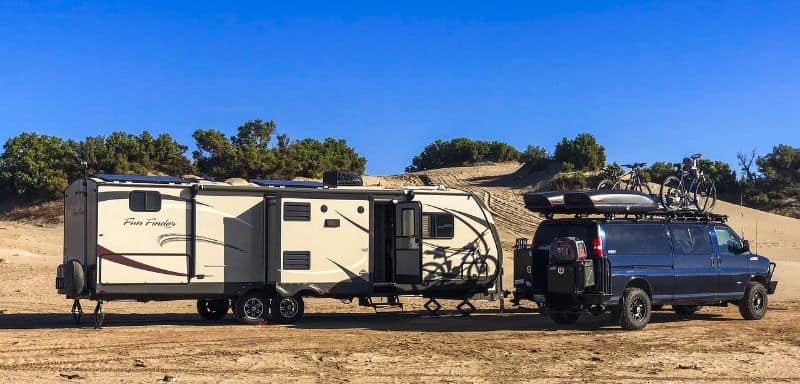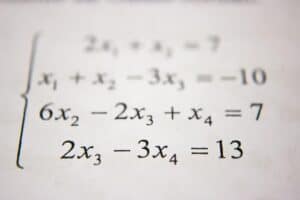It’s like the 1988 Cinderella rock band hair balad: “You don’t know what you got till it’s goooooone!”
Amps are like that. You don’t appreciate them until your battery’s fresh out and you’re buried under three blankets and yesterday’s jeans, trying to keep warm on a 34-degree moonless night.
Maybe you’re wondering, “Why is my RV battery draining so fast?”
You need to know how long your RV battery can last!

How to Figure Out How Long Your RV Battery Will Last
If you’re willing to venture off the beaten KOA path, you’ll find thousands of tempting lake shores, forest dens and mountain hillsides. But there’s a catch. There are no hookups, no grid, no friendly outlets.
This is called “boondocking” or “dry camping.” And if you want to dip a toe in the waters, the very first thing you must know is how long your RV can run without plugged-in power.
This is when most people launch into a detailed explanation of amp-hours, wattages, inverter losses, inductive motor loads, averaged daily usage, etc.
That’s for another article. This is an article for people who just want some answers, who want ‘em fast, and don’t want any algebra on the side, thank you very much!
Steps to Success: Calculating RV Power Needs
Well then, here’s what you do.
- You read the rest of this article to understand some simple power principles. Don’t worry, it’s not too hard.
- You fill out this RV Battery Life calculator to give you a rough idea of your estimated battery life.
- You take your rig on an experimental weekend trip and see how long the battery lasts with normal usage.
Start Here: The RV Battery Sticker

Let’s start with a simple question: How much energy can I store in my batteries?
It’s easy – just look at your battery! Every deep-cycle battery will have a sticker telling you exactly how many amp-hours (Ah) it has.
Just add ‘em all up. Two batteries, each with 110 Ah? You have 220 Ah! Congratulations! This game works like basketball: The more points, the better.
By the way, if your battery is only rated in CCA (cold-cranking amps), then you’re running the wrong kind of battery, probably a medium-duty marine battery. There’s no perfect conversion between CCA and Ah, but you can divide the CCA by 7.25 for an Ah estimate.
Meet the Electricity Family: AC Power, DC Power
Most RVs and travel trailers use two “types” of electricity:
- 12-volt direct current (12V DC)
- 120V-volt alternating current (120V AC)*
With the right machine, you can transform one type of electricity into another!
- To go AC-to-DC, you use a converter. Every RV has one!
- To go DC-to-AC, you use an inverter. NOT every RV comes with an inverter. Inverters are only installed at the factory for larger travel trailers, luxury fifth wheels, etc. You can also purchase one aftermarket.
Batteries normally provide 12V DC power, and shore power gives you 120V AC power.
Some objects, like your LED cabin lights, can only run on DC power. Others, like your rooftop air conditioner and microwave, can only run on AC power.
Don’t get confused! Apples grow on apple trees, and oranges grow on orange trees. 12V DC = battery, 120V AC = plug-in.
*For our purposes, references to 110V, 115V, 120V, and 125V AC electricity are all the same “type.”
A Detour into Ohm’s Law for RVers

Public Service Announcement: Math is AHEAD!
If you want to skip the detour, here’s the Rule of Thumb:
One 12V (DC) amp ~ About 10 120V (AC) amps
You’re welcome. You can skip the rest of this section if you want.
Technically, an amp is an amp is an amp, so the above equation is scientifically incorrect. But it’s close enough for gvnm’t work.
If you want to know a little more of the “how” behind the “what,” here it is:
V = IR
V = IR is an abbreviated version of Ohm’s Law. Voltage equals current times resistance. And if you don’t understand what that means, that’s totally okay.
Most RVer’s use a derived version of Ohm’s Law called Watt’s Law:
P = IV
Power equals current times voltage.
Again, if you can’t recite the dictionary definitions of those terms, don’t worry about it. We normally specify power in watts (W), current in amps (A), and voltage in volts (V).
So let me rewrite that equation in terms of its units (that’s how I remember it):
W = AV
Notice that if you divide W by V …
W/V = A
You’ll get A!
That’s where we got our rule. And that’s the end of our math section.
120V/12V = 10, so 1 DC Amp ~ 10 AC amps*
This is exactly why you usually can’t run an RV air conditioner on battery power!
*Again, technically, there’s no such thing as a DC Amp. Current is current. But that’s how most people remember it.
Let’s take a look at an example of how to calculate your RV appliance amperage.
Let’s say your RV microwave is rated at 700W. If we divide the wattage by its 120V AC voltage requirement, then we get 5.8 AC camps. BUT … if we divide 700W by 12V DC – then we get 58 DC amps! See how one is 10x bigger?
A Note on RV DC-to-AC Power Conversion Efficiency
W = AV assumes perfect efficiency. That never happens. When you convert or invert power, you lose some of it.
Again, this is where many articles dive into modified vs pure sine wave inverters, diodes, etc.
Let’s skip all that. Normally, you only care about efficiency when you’re inverting power – when you’re trying to run a microwave off your battery, for instance. A run-of-the-mill inverter is around 80% efficient.
That means you’ll actually need about 70 DC amps to power your 700W microwave.
So if you convert “5 apples” of DC power to AC power, you now only have “4 apples.” One got eaten along the way. In the case of electricity, it normally just turns into heat. That’s why your computer cord gets hot when you leave it plugged in.
Calculating Amp-Hours for RV Battery Power Life

Now, remember those batteries you looked at? Remember how you added up their capacities and found out you had 220 amp-hours?
Amp-hours?
Hmmm … the plot thickens.
So if we count up how many amps we’re using … maybe we’ll know how many hours of power we have? Reader, you’re a genius!
And that’s exactly what you do. You find the amp draw for every single feature. Think of it like playing Pokemon Go.
Most items will have stickers on them. If the stickers only give you watts, just divide by the voltage, and that’s your amps. Or you can Google the product name, and the product description page or technical manual will tell you its wattage or amp draw.
How Much Run Time Per Appliance?

You don’t run your microwave all day, do you? How about the water pump? Of course not! And when these features are turned off, they aren’t using power.
So you need to know how often you run each feature every 24 hours. Don’t sweat the details. You’re just looking for an estimate.
- Microwave: Just breakfast and the occasional midnight snack. Say 30 minutes?
- Ceiling fan: When it’s nice out, all night! So about 12 hours.
- TV: Maybe a movie in the evening, so 2.5 hrs?
And so forth. If you want exact numbers, use a watt-meter.
Now plug all these numbers into the RV Battery Life calculator, and you find out how long your battery will last without shore power!
Unfortunately, maybe the calculator said you only have enough battery power for 12 hours. You want to camp for a whole weekend! What do you do? Or maybe you want to know how an RV generator or RV solar panels will affect your battery life.
You read on, dear Reader. You read on.
Leave a Reply